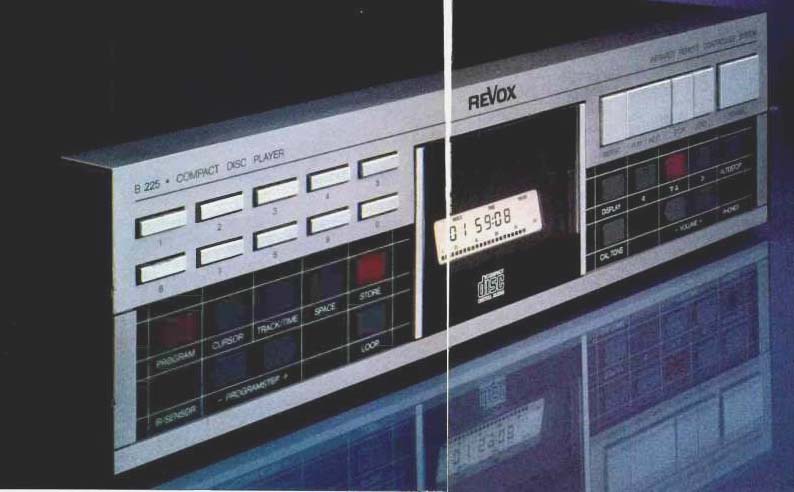
Manufacturer's Specifications:
Frequency Response: 20 Hz to 20 kHz. ±0.6 dB.
Signal-to-Noise Ratio: Greater than 96 dB, 20 Hz to 20 kHz, unwtd.
Total Harmonic Distortion: Less than 0.006%, 20 Hz to 20 kHz.
Channel Separation: More than 90 dB, 20 Hz to 20 kHz.
Output Level: 2.0 V, fixed; 0 to 2.0 V, variable.
Headphone Level: 13 volts p-p, 35 mW into 600 ohms.
Number of Programmable Selections: 19.
Search Time for Any Location: Less than 4 S.
Wow and Flutter: Below measurable limits.
Power Consumption: 40 watts maximum.
Dimensions: 17.75 in. (45.0 cm) W x 4.25 in. (10.9 cm) H x 13.0 in. (33.2 cm) D.
Price: $1,150.00.
Company Address: 1425 Elm Hill Pike, Nashville, Tenn. 37210, USA.
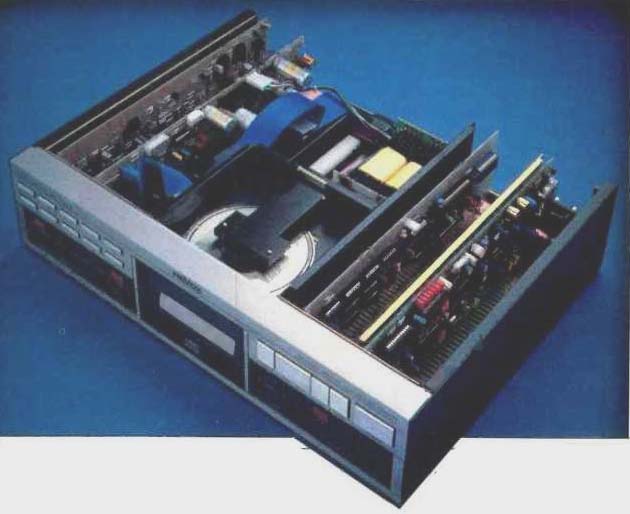
It comes as no surprise to me that this first Compact Disc player to be built by Studer-Revox is one of the most sophisticated, rugged, yet easy-to-use units of its kind that I have ever tested. After all, Studer and Revox tape equipment is used in broadcast and recording studios throughout the world, and Revox products (the brand name used on Studer's consumer products) are regarded by many to have the same attributes as the company's professional components. What did surprise me was the suggested retail price of the unit. I had fully expected the Revox CD player to be among the world's most expensive as well as among the world's best. While it certainly lived up to the latter expectation, its price was no higher than that on some of the first-generation CD players which offered only a fraction of this unit's versatility.
The B225's programming facilities are unusually elaborate, and some are unique. Programs can be up to 19 steps long. Notice I said "steps," not "selections"-each step can include any number of consecutive selections, on their original order. Selections can be programmed by track number or by time from the beginning of the disc-or you can program the start of a selection one way and program its end the other way. Program memory is nonvolatile, so it will retain its contents even if you shut the B225 off or accidentally unplug it.
The three functions which Revox calls "special program steps" are even more unusual. Entering the " Loop" command as a program step makes the program repeat endlessly until stopped. (If pressed in normal play mode, the " Loop" button repeats the entire CD.) The program can pause automatically after any selection, until the pause key is pressed--and can also output the 1-kHz calibration tone to remind you that the program has paused. The player can even be set to turn itself completely off at the program's end! Even handier, perhaps, the program can be "paged" through for checking and then modified without erasing it or starting over.
On the technical side, the B225 follows the Philips system of four-time oversampling (at 176.4 kHz-see April, 1984 Audio), with both digital and analog filters, using digital filters specially designed for Revox by Dr. Roger Lagadec.
Control Layout
The first thing I noticed was the panel's logical layout.
Often-used controls occupy the right third of the panel, while programming controls are grouped to the left. In the center is the disc drawer, with a multifunction display on its front surface.
The controls at the right include the "Power" switch, and a group of four keys: "Repeat," "Play/Next" (to start play or, if playing, move to the next track or next programmed step), "Stop," and "Load" (to open and close the drawer). Below are five more buttons: "Display" (which switches the display between time elapsed in the current selection and time elapsed since the beginning of the disc), keys to skip back or ahead and to pause or restart play, and an "Autostop" key (which makes the player pause at the end of each selection or program step, resuming when the pause key is pressed). At the bottom of this section are the " Cal. Tone" button (which sends a 1-kHz tone to the output jacks, at the maximum level possible from a CD, for adjusting tape recorder levels) and the up/down "Volume" buttons (which control the adjacent headphone jack and the variable-level outputs on the rear panel).
The B225's display offers a wealth of useful information. In normal (non-programmed) play, it shows track and index number, time since the beginning of the current track (or since the start of the disc), and shows whether the "Pause," "Autostop" or "Loop" modes have been activated. If the player finds index signals on the disc, the word "Index" comes on the display, with the current index number just beneath it; there is no way of accessing selections by index number, though.
In programmed play, the display shows the word "Step" to indicate the programmed mode and shows the number of the step being executed. The next field of the display shows the track number or timing that started the selection, with the following field showing the track number or timing (if any) programmed as the selection's end point.
One display function remains the same in both programmed and normal play. When the disc is first loaded, a horizontal line of square bars appears along the bottom of the display, indicating how many selections (up to 30) are on the disc. These bars disappear, one by one, as the tracks they designate are played.
Several of the controls in the programming area at the left can be used for normal play as well. The 10 numbered buttons at the top of this section can be used for direct access to any given track in normal play, as well as for programming track number or selection time (from the beginning of the disc). The " Loop" button at the bottom left repeats the entire CD in normal play, or the entire program during programmed play. The others are for programming only. Pressing "Program" puts the B225 in program-entry mode, which can be done even while a disc is playing in normal mode. The "Store" button enters commands in memory. The "Track/Time" button switches selection start or end-point entry and display between track-number and elapsed-time modes. Start and end points can also be marked while the disc is playing, by pressing the "Mark" button as the desired points come by. Two additional buttons allow you to "page" through a previously entered program, forward or backward, to check or edit it. A "Cursor" key is used to move from field to field of the display when editing a program, or to switch, in elapsed-time programming, from minutes to seconds.
A sensor at the lower left of the panel receives infrared signals from Revox's optional B201 wireless remote-control unit ($125); a light behind the sensor panel blinks to acknowledge commands. The B201 commands the B225's "Play/Next," "Stop," skip-ahead, skip-back, and pause functions, plus direct numerical track entry. The B201 can also be used with Revox's B251 amplifier, B261 tuner, B710 Mk II cassette deck, and the B791 and B795 turntables. To keep the button count down to a reasonable number (38!), the remote does not provide separate buttons for the CD player functions, but requires that a "*"key be pressed concurrently with each button when commanding the B225.
If the remote is to be used only with the CD player, it can be modified so that the "*" key need not be pressed.
The rear panel of the B225 is equipped with fixed- and variable-level output-jack pairs, a power-cord receptacle and a multi-pin remote socket for connecting a wired remote control. Connecting such a remote automatically disables the infrared receiver.
Reading about all the B225's controls may perhaps intimidate you a bit-when I first read the owner's manual, before actually using the deck, I figured I'd need several hours to master everything. In fact, once I started dealing with this magnificent product, I was able to use and program it almost immediately-that's how well the panel is laid out, and how succinctly and clearly the controls are labeled.
Measurements
After marveling at the extraordinary flexibility of this beautifully crafted machine, I got down to measuring its actual performance. As I have found again and again over the years, Revox's published specifications were unusually conservative. Figure 1 shows a plot of frequency response for both the left and right channels of the B225. The vertical scale is 2 dB per division, and the sweep, from left to right, extends from 20 Hz to 20 kHz. Frequency response was extremely flat, deviating by no more than ±0.2 dB. Harmonic distortion for maximum output varied from 0.003% to around 0.006%, depending upon the test frequency being measured. A plot of THD versus frequency up to around 10 kHz, at various recorded levels, is shown in Fig. 2.
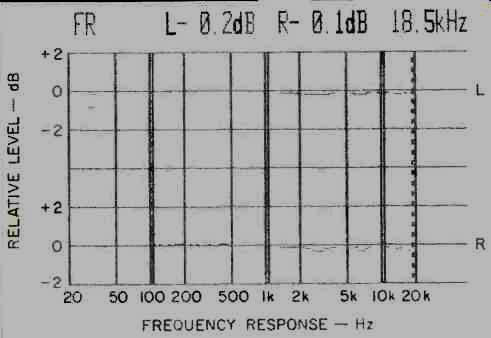
Fig. 1--Frequency response, left (top) and right channels, at 0-dB level.
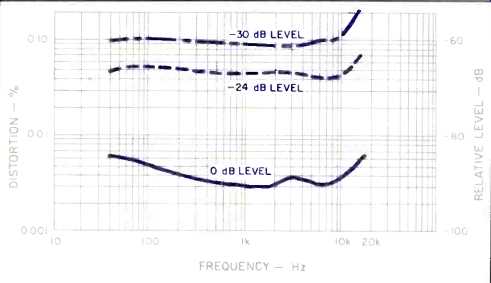
Fig. 2--THD vs. frequency at levels of (from top to bottom)-30, 24 and 0 dB.
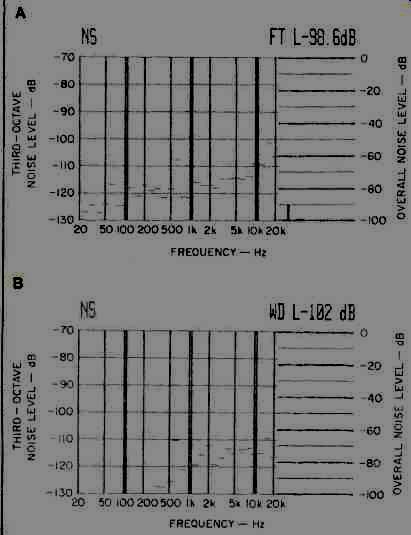
Fig. 3--S/N analysis, both unweighted (A) and A-weighted (B).
Unweighted S/N measured 98.6 dB (Fig. 3A) while, with A-weighting, it increased to 102 dB (Fig. 3B). At maximum recorded level, IM distortion measured 0.0055%, increasing to 0.065% at-20 dB recorded level. Linearity was accurate to within 0.2 dB down to-80 dB. Stereo separation (Fig. 4) ranged from 80 dB at the low and high frequency extremes to around 89 dB at mid-frequencies.
Reproduction of a 1-kHz, digitally generated square-wave signal is shown in Fig. 5. The reproduced waveform is typical of that obtained with CD players that use digital filtering ahead of their D/A converters, as this one does.
(The filters used here are Revox's own design.) Playback of a digitally generated unit-pulse signal was also typical of players using this type of filtering (Fig. 6). The 'scope photo of Fig. 7 shows negligible phase shift between a left-channel, 200-Hz test signal and a right-channel, 2-kHz one. It should be noted that the B225 has two independent D/A conversion circuits, which eliminate one source of time delay or phase differential between channels.
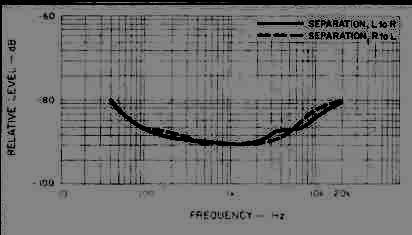
Fig. 4--Separation vs. frequency.
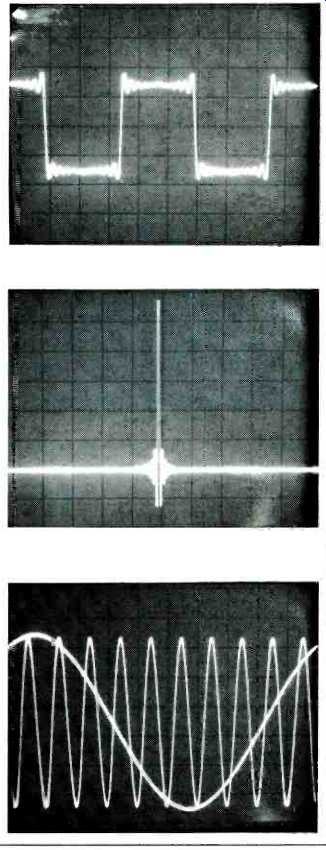
Fig. 5--Square-wave reproduction, 1 kHz.
Fig. 6--Single-pulse test.
Fig. 7--Two-tone phase test (200 Hz left channel, 2 kHz right).
Use and Listening Tests
In their white paper on the technology of the B225, Revox claims the unit "doesn't mistrack, even in very stressful situations," thanks to its pivoting-arm laser assembly. As to error-correction, the paper claims that "The B225 plays all damaged records. It is the only CD player capable of this." The only restriction cited is that "Discs in very bad shape (broken, pierced, scratched all over the surface) will still be perfectly reproduced, but cannot be programmed."
Well, I wasn't about to break, pierce, or scratch all over their surfaces any of my favorite musical CDs to prove the point, and I suspect that even at Revox, copywriters can get to be a bit over-enthusiastic. This much I can say, with certainty, however. The Revox B225 had no trouble whatsoever playing through (and ignoring) all of the defects built into my special Philips test disc. That means that it was able to correct for dropouts extending to 900 microns in length, simulated dust or dirt spots 900 microns in diameter, and a long, semi-opaque simulated fingerprint smudge. I must also confess that I was a bit more brutal than usual in my "tapping tests" along the sides and top of this rugged unit, yet still I failed to cause any mistracking during these "shock tests." If you are looking for a CD player that doesn't occupy very much space on your shelf or table top, this is probably not the unit for you. There are CD players around that are much smaller in size and lighter in weight. If, however, you are looking for a CD player that is more versatile in its programming capabilities than just about any other player available, you would do well to consider the long-awaited Revox B225 very seriously. I have been an admirer of Revox and Studer products for many years and have been privileged to visit the Studer factories in Switzerland and Germany and to meet and talk with the company's legendary founder, Dr. Willi Studer. Having had the pleasure of listening to Dr. Studer explain his philosophy of product design and quality.
I expected nothing less than sonic and mechanical perfection from the company's first CD player.
I was not disappointed in the least. Sound quality was beyond reproach. I know that in the past I have repeatedly stressed that there is little audible difference between one CD player and the next. Nevertheless, I felt that the Revox B225 sounded cleaner; instruments seemed better defined during ensemble playing and in orchestral works. Stereo imaging was magnificent when I played some of my most recent CD acquisitions. I wondered whether my positive reaction to the sound of this player was purely psychological (stemming from my admiration for the engineering and layout of the instrument) or whether it was, in fact, the result of an audible difference between this CD player and others I have tested. I suppose I will never really know. The ease with which complex programming could be accomplished on this superbly engineered machine seemed a fitting accompaniment to the high technology involved in the actual playing and tracking of CDs. All in all, the Revox B225 is a superb instrument. I simply can't find anything to criticize, nor can I think of a single feature or control that I would have arranged differently. As is usual with Revox, where new designs are concerned, it took the company quite a long time to come up with their first CD player. But it was certainly worth waiting for!
--Leonard Feldman
(Source: Audio magazine, Sept. 1984)
Also see: Revox B226-S CD Player (Mar. 1990)
Revox B215 Cassette Deck (July 1985)
Toshiba XR-Z90 Compact Disc Player (Dec. 1983)
= = = =